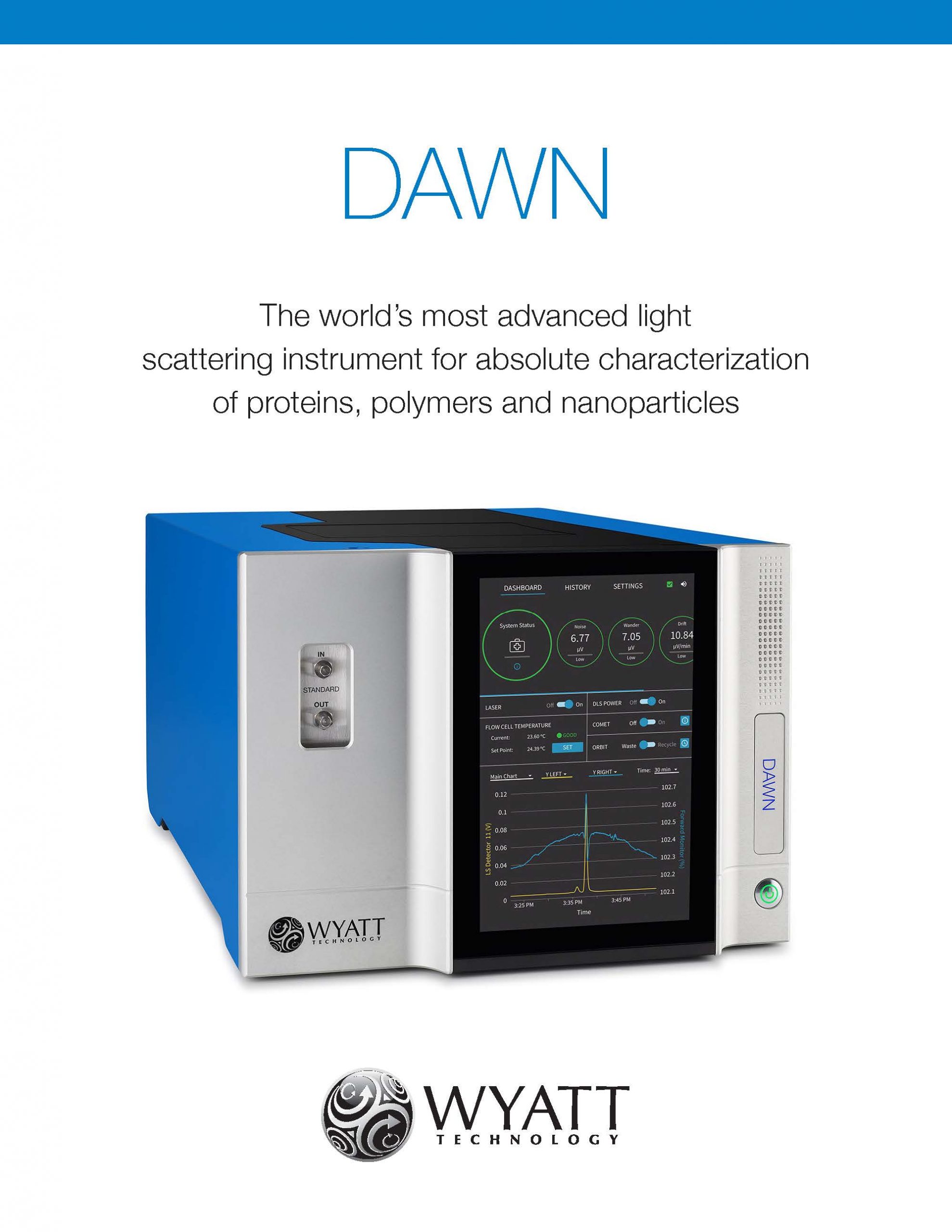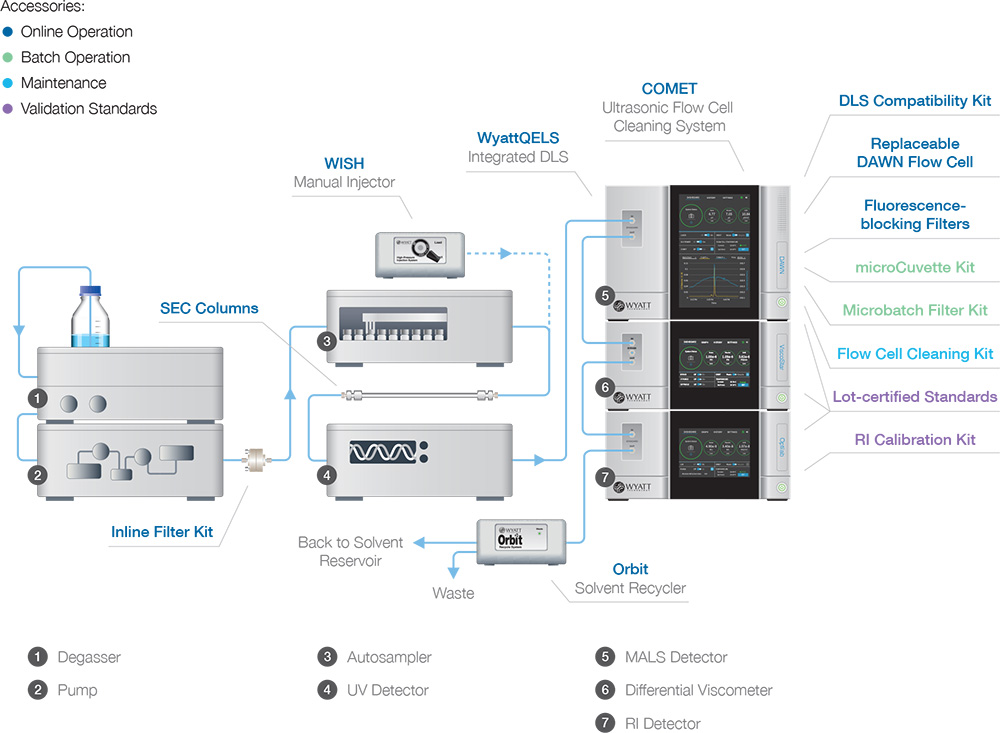DAWN™
Product Overview
Product Description
Brochure
Options
On-Line Operation
Batch Operation
Accessories
Software
Specifications
Other MALS Instruments
Publications
Request Info
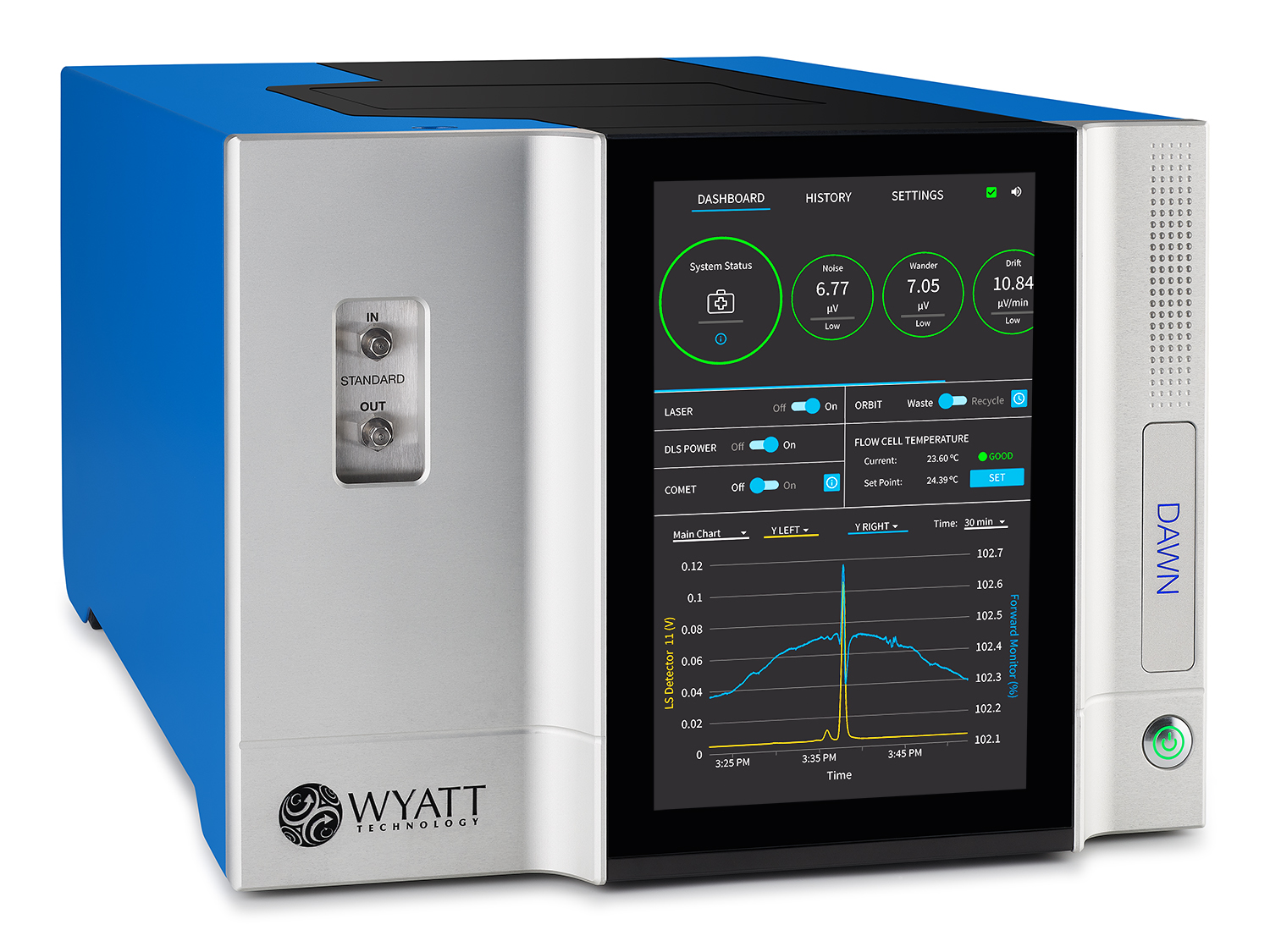
The world's most advanced light scattering instrument for absolute characterization of proteins, conjugates, macromolecules, and nanoparticles.
Premier MALS
The DAWN instrument is the premier Multi-Angle static Light Scattering (MALS) detector for absolute characterization of the molar mass and size of macromolecules and nanoparticles in solution. It offers the highest sensitivity, the widest range of molecular weight, size, and concentration, and the largest selection of configurations and optional modules for enhanced capabilities.
Separation First
MALS is most often used in conjunction with a separation system such as Gel Permeation Chromatography (GPC-MALS), Size Exclusion Chromatography (SEC-MALS), or Field-Flow Fractionation (FFF-MALS) to determine distributions of mass, size, and composition, independent of column calibration by reference standards.
Supported by ASTRA™ Software
ASTRA Software and its built-in analysis modules support the DAWN MALS instrument, providing the most versatile analysis available for online multi-angle and dynamic light scattering measurements.Overview
The DAWN and its companion Optilab™ dRI detector are the established benchmarks for MALS analysis, cited in thousands of peer-reviewed publications. Multi-angle light scattering detection is indispensable for use with GPC and HPLC-SEC in order to obtain reliable molecular mass distributions and information on molecular conformation, branching ratio, fragments and aggregates.
SEC-MALS with a DAWN and Optilab characterizes conformation and branching of synthetic and natural polymers larger than 10 nm in rms radius Rg. The addition of a ViscoStar™ differential viscometer creates a GPC triple-detection system that can analyze molecular conformation and size below the Rg limit of 10 nm and determine Mark-Houwink Sakurada coefficients.
The combination of a UV/Vis absorbance detector with a DAWN instrument and Optilab refractive index detector creates a UV-MALS-RI triple-detection system, for analysis of copolymers and protein conjugates (glycoproteins, PEGylated proteins, surfactant-bound membrane proteins, etc.). With the addition of a WyattQELS™ DLS module for size determination, protein conformation may be analyzed.
- Mw from 200 Da to 1000 MDa
- Sensitivity: 10 ng/mL 100 kDa polystyrene in THF, 0.4 µg/mL BSA (66.4 kDa) in PBS
- Rg from 10 to 500 nm, up to 1000 nm with shape-specific models
- Ultra-stable, high-power laser
The DAWN may also be used in batch (off-line) mode to characterize the weight-average molar mass, z-average size and second virial coefficient of unfractionated samples.
In conjunction with a Calypso™ CG-MALS system, the DAWN characterizes macromolecular interactions, label-free and immobilization-free: affinity and absolute stoichiometry of self- and hetero-association of simple or complex molecular systems. The Calypso system also automates the determination of second virial coefficients, cross virial coefficients, average molar masses and sizes.
Ultrasonic Cleaning Included
Each DAWN instrument includes an embedded COMET™ ultrasonic transducer that cleans the flow cell automatically by agitating the fluid and loosening particles from the glass surfaces.
Temperature-Controlled Models
- Ambient model
- Ultra-High-Temperature (UHT) model, from ambient up to +210 °C
- Standard Peltier heated/cooled (H/C) model, temperature control from -15 °C to +150 °C
The world's most advanced light scattering instrument for absolute characterization of proteins, polymers and nanoparticles
Click here to request a copy of our DAWN brochure.
Dynamic Light Scattering
WyattQELS™ - A dynamic light scattering (DLS) detection module which integrates inside the DAWN to provide simultaneous DLS measurements in the same scattering volume. The optical fiber may be located in one of four angular positions, at 50.5°, 90°, 135° or 150°. ASTRA software automatically detects the occupied position.
Alternatively, connect an external DLS instrument via fiber optic cable - both the DynaPro™ NanoStar™ and DynaPro™ ZetaStar™ can do double duty as batch and online DLS instruments. Since they collect light directly from the MALS flow cell, the mass/size correlation is still dispersionless.
Temperature-Controlled Models
- Ambient model
- Ultra-High-Temperature (UHT) model, from ambient up to +210 °C
- Standard Peltier heated/cooled (H/C) model, temperature control from -15 to 150°C
The Ultra-High-Temperature DAWN interfaces with high temperature GPC systems such as the Tosoh EcoSEC GPC-HT or the Polymer Char GPC-IR.
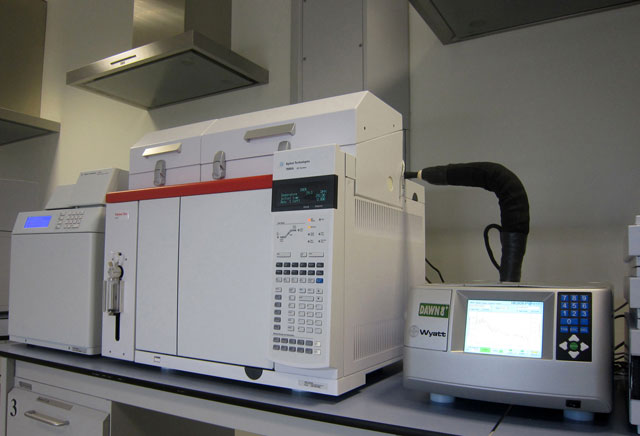
DAWN-Polymer Char GPC interface
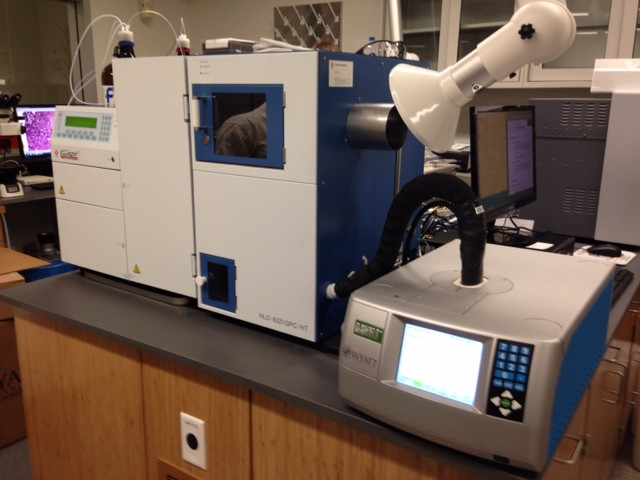
DAWN-Tosoh GPC-HT interface
Laser Wavelength
The standard 658 nm red laser may be replaced in the factory with an infrared laser operating at 785 nm. The IR laser minimizes or prevents sample fluorescence to ensure correct molar mass and size measurements on samples that fluoresce under 658 nm excitation. Please contact Wyatt for available laser wavelengths. Narrow bandpass fluorescence-blocking filters are also available.
Optical Filters
Optional polarization or fluorescence-blocking filters may be installed in the DAWN. Fluorescence-blocking filters improve greatly the analysis of samples that fluoresce upon irradiation at the laser wavelength.
The DAWN may be positioned downstream of all types of standard GPC, HPLC or FPLC systems for analysis of molar mass and size distributions (see SEC-MALS), and derivatives such as conjugation and conformation analyses, all included in the ASTRA™ data collection and analysis software. For those systems equipped with a UV, RI, fluorescence or other concentration detector, the DAWN accepts up to 4 analog inputs so a 3rd-party concentration signal may be used in MALS calculations of molar mass. The DAWN is generally set up downstream of a UV detector and upstream of a RI detector.
In most cases it is beneficial to connect an Optilab™ RI detector to the eluent stream. This permits universal concentration detection regardless of fluorophores or chromaphores. The combination of UV and RI signals, acquired simultaneously, is utilized in ASTRA's Conjugation Analysis algorithm to characterize binary complexes such as glycoproteins, PEGylated proteins, or block co-polymers.
The DAWN may also be connected to an Eclipse™ FFF system for characterization of macromolecules and nanoparticles from 1 nm to 1 µm via FFF-MALS.
Both SEC-MALS and FFF-MALS will benefit from an additional WyattQELS™ module for measuring nanoparticle size via dynamic light scattering (DLS). The WyattQELS utilizes the same laser and flow cell volume as MALS detection. The optical fiber may be located in one of the 4 angular positions.
For analysis of natural and synthetic polymers, the ViscoStar™ detector may also be added as well. Differential viscometry is an orthogonal means of determining molar mass and conformation.
MALS detectors may be operated in batch mode when the analysis does not benefit from separation:
- If the sample is not amenable to separation by SEC or FFF (e.g., very large and diffuse polymers such as PMMA) to measure weight-average molar mass, and size as z-average radius
- In order to validate SEC-MALS measurements:
- to determine if large aggregates or other species are filtered out on the column
- to determine if reversible aggregates dissociate subsequent to dilution on the column or separation channel
- In order to characterize macromolecular or nanoparticle complexes which are disrupted by column shear or dilution
- In order to measure binding affinity or reaction kinetics of macromolecules such as protein-ligand interactions
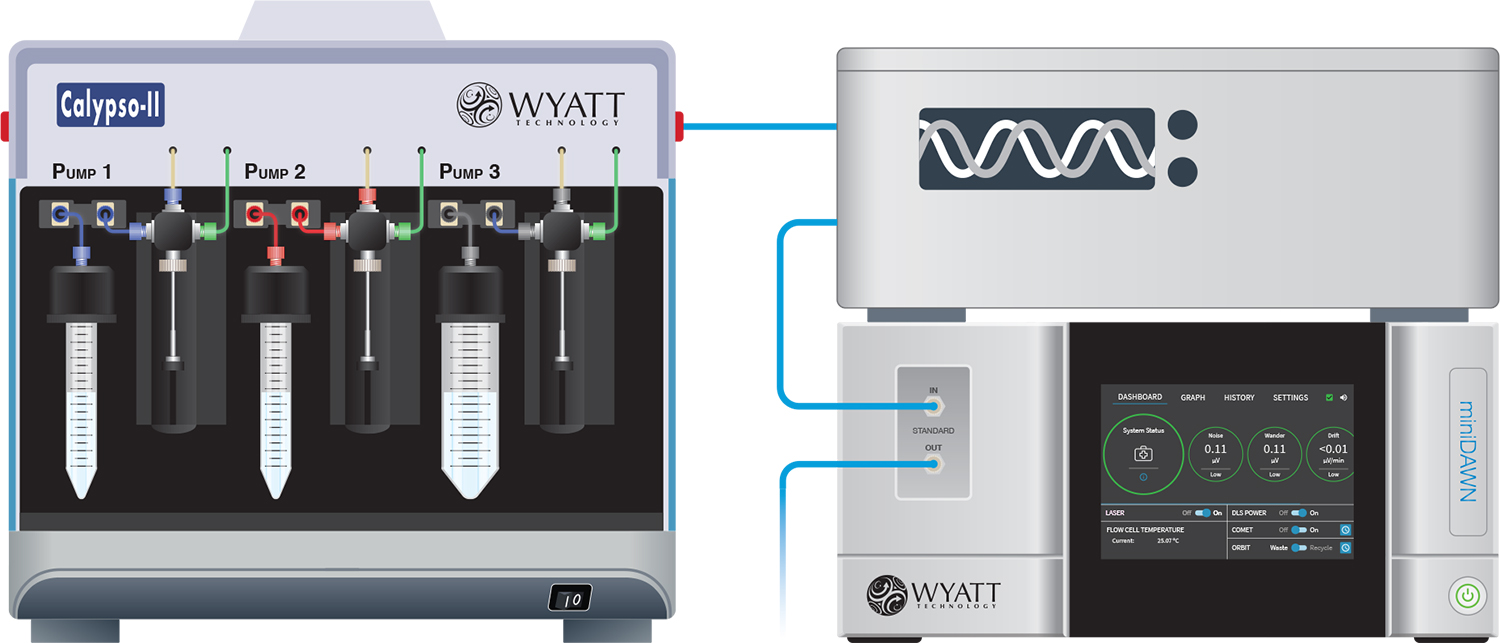
Calypso™ - Automated sample preparation and delivery system for carrying out and analyzing composition-gradient MALS in a DAWN. Analyses include biomolecular interactions, high-concentration protein-protein interactions, Zimm plots and dn/dc as well as time-resolved MALS. Utilizes the CALYPSO™ software for interaction analysis.
microCuvette™ - Allows static and dynamic light scattering measurements to be made simultaneously in a MALS detector using a quartz cuvette, requiring only 10 µL.
NanoFilter Kit - Makes it easy to filter, recover and refilter precious sample. This is especially useful when your total sample volumes are below 300 µL.
Microbatch Kit - Used to inject samples into the flow cell of a MALS detector, and in determining dn/dc with an RI detector.
ASTRA™ - Our comprehensive software solution for MALS and DLS analysis in chromatography, field flow fractionation or batch mode.
ASTRA software offers a suite of basic and advanced analyses, including customized reports and an optional 21 CFR Part 11 compliant security and database package.
Optional HPLC CONNECT™ software provides integrated control of your HPLC stack with full digital synchronization between your HPLC system and Wyatt detectors – all within ASTRA.
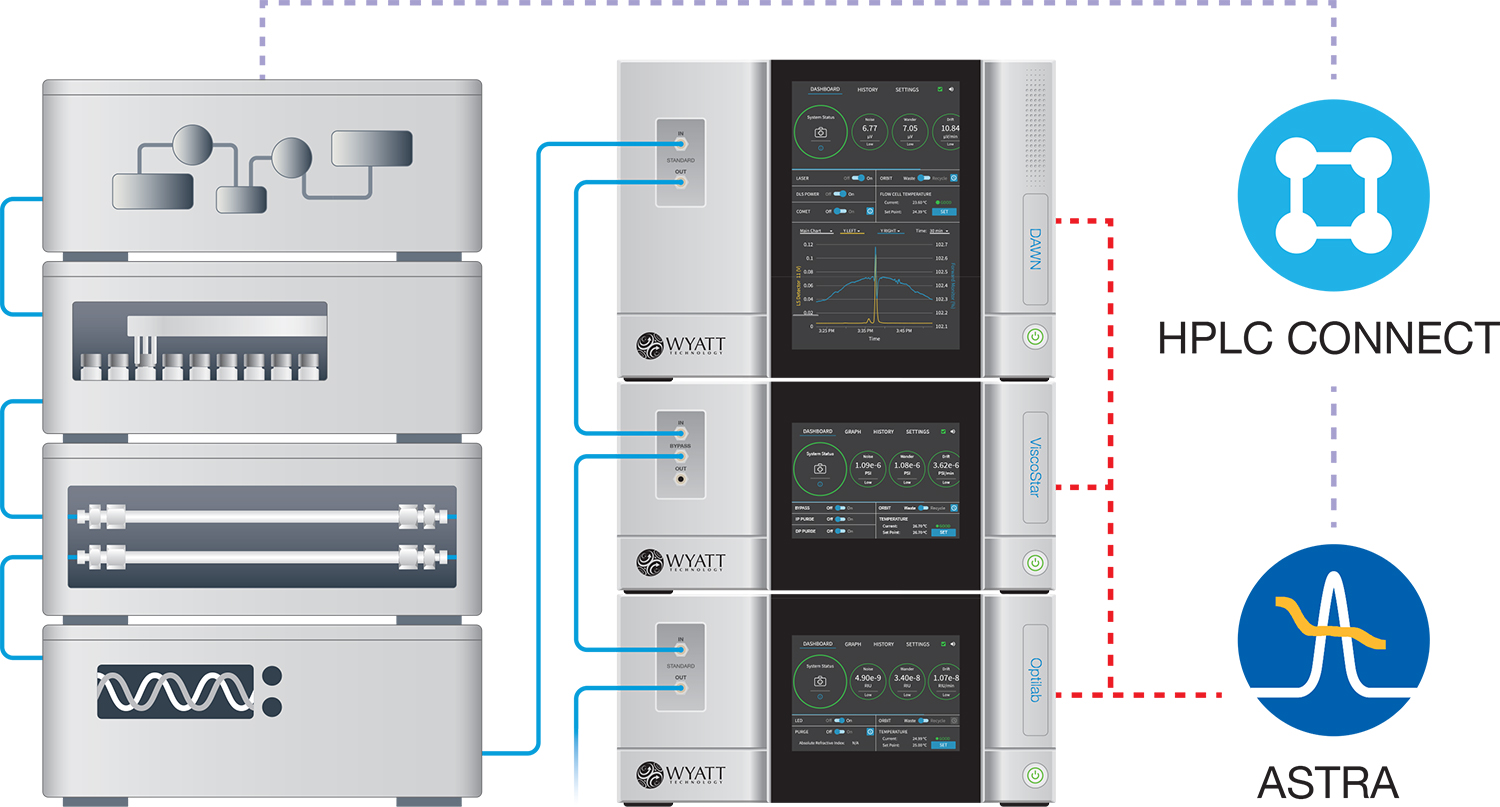
ASTRA's Method Builder simplifies the specification of methods for the most common analyses, in three intuitive steps:
- Choose your scientific application
- Specify the instruments
- Enter sample and run parameters
Maximize your productivity via ASTRA's One-Click MW™ feature, automated multi-sequence processing and HPLC/UHPLC integration. ASTRA will:
- Synchronize data collection with your HPLC or UHPLC
- Autoprocess data to determine MW and radius
- Generate custom reports and graphs
- Prepare for the next run
| Measurements | |
| Molar Mass Range | 200 Da to 1 GDa1 |
| Molecular Size Range (Rg) | ≈ 10 to 500 nm, up to 1000 nm with shape-specific models |
| Molecular Size Range (Rh) | In flow mode, 0.5 nm to 300 nm2; batch mode 0.5 nm to 1 μm (requires WyattQELS™ DLS module or DynaPro™ NanoStar™ + fiber optic connection). |
| Sensitivity | 10 ng of 100 kDa polystyrene in THF or 200 ng of BSA in PBS, assuming standard 7.8 mm x 300 mm SEC column and no post-column filter |
| Fluidics | |
| Mobile Phase Compatibility | All-solvent compatible (aqueous and organic). Wetted materials are 316 stainless steel, fused silica or F2 glass, and Kalrez. |
| Optics | |
| Detectors | |
| MALS Detectors | High-gain, high dynamic range photodiodes at 18 detection angles. |
| Auxiliary Detectors | Laser monitor for stabilization feedback; forward transmission monitor to correct signals for absorbing samples and to assess data quality. |
| Dynamic Range | 3,300,000:1 |
| DLS Detector (optional) | WyattQELS dynamic light scattering module installs directly inside the DAWN chassis. Alternatively, the optical fiber pickup of the DynaPro NanoStar cuvette-based DLS instrument or Mobius DLS-ELS instrument may be installed in the DAWN. |
| Laser Properties | |
| Laser Wavelength | 658 nm ± 4 nm; 785 nm optional for use with fluorescing samples |
| Laser Power Control | Programmable 10% to 100% |
| Flow Cells | Fused Silica, optimal for solvent refractive index less than 1.50; F2, optimal for solvent refractive index above 1.50 |
| Temperature Options | Ambient Heated/Cooled (HC) -15 °C to +150 °C Ultra-High-Temperature (UHT) ambient to +210 °C |
| Electronics | |
| Analog Inputs | 4 differential analog inputs with 24 bit resolution. Input range -10 V to +10 V |
| Analog Outputs | 2 analog outputs from user selectable measurements channels -10 V to +10 V |
| Other Inputs/Outputs | Alarm in, Alarm out/retransmit, Auto-Inject in, Auto inject contact closure retransmit, Recycle In/Out (operates Orbit™ recycle valve) |
| Computer Interface | Ethernet |
| Front Panel Display | 10.1" (257 mm), capacitive high-resolution screen with multi-touch functionality, displays signals, graphs, instrument settings and diagnostics |
| Dimensions | 58 cm (L) x 36 cm (W) x 26 cm (H) |
1Depending on dn/dc, the sample concentration and chromatography conditions, this is typical.
2Upper limit depends on configuration and flow rate.
Host PC requirements may be found in Computer Requirements.
Specifications subject to change without notice.
Other MALS Instruments
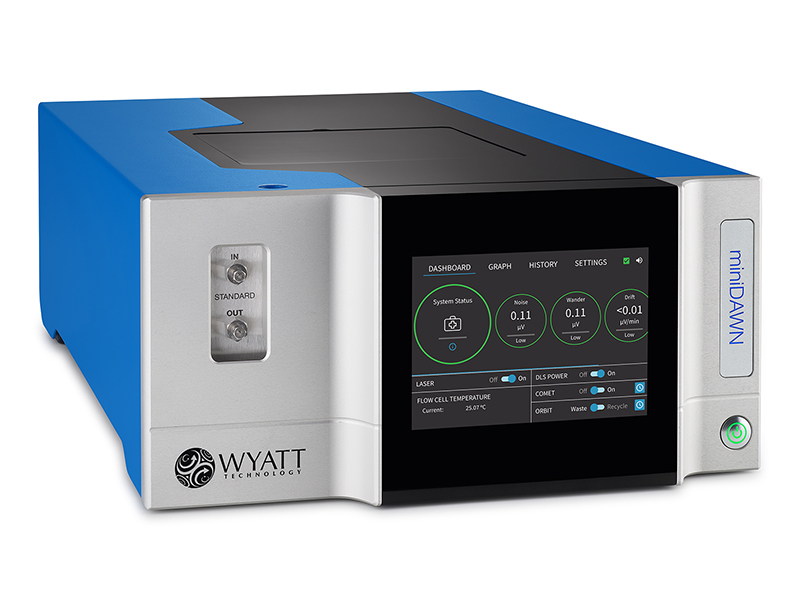
miniDAWN™ - Second only to the DAWN in sensitivity. Incorporates detectors at 3 angles to determine molar masses from 200 Da to 10 MDa and radii from 10 – 50 nm. Ambient only.
microDAWN™ - The first MALS detector for UHPLC, with interdetector dispersion as low as 1.5 µL. Incorporates detectors at 3 angles to determine molar masses from 200 Da to 20 MDa and radii from 10 – 50 nm. Ambient only.
ultraDAWN™ - Measures multi-angle light scattering and reports the results – weight-average molecular weight Mw and rms radius Rg – in real time.

